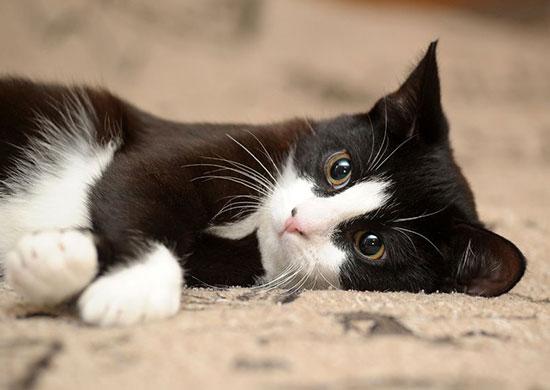This content is archived from the Feline Nutrition Foundation
Cat Scratch Fever: How It Affects Cats
- Updated: Tuesday, April 30, 2019 05:49 PM
- Published: Monday, May 26, 2014 06:29 PM
- Written by Guillermo Díaz. MV
 My vet suggested my cat have a test for Bartonella infection. I thought that cats didn't experience symptoms from infection with this bacterium, that it was only people that had to worry about becoming infected. Can my cat get sick from "cat scratch fever?"
My vet suggested my cat have a test for Bartonella infection. I thought that cats didn't experience symptoms from infection with this bacterium, that it was only people that had to worry about becoming infected. Can my cat get sick from "cat scratch fever?"
Regarding cat health, there are certainly lots of conditions that are not directly food-related that worry dedicated cat owners. One of the diseases I am most frequently asked about is bartonellosis. Bartonella species are very small intracellular bacteria that can survive and replicate within erythrocytes.¹ Different Bartonella species have adapted to specific mammalian reservoir hosts and can infect and occasionally cause disease in incidental hosts. More than ten species of Bartonella infect cats or dogs worldwide.²
Some Bartonella species can infect humans, who may develop fever, malaise, lymphadenopathy and skin eruptions following cat scratches or bites.³ It is commonly known in humans as "cat scratch fever." Various mammalian hosts are adapted to the various Bartonella species and maintain bacteremia for long periods subclinically, without any effects. These bacteria are spread by a variety of vectors such as flies, sand flies, ticks and lice. Several Bartonella species have been identified in cats, but the primary species of concern is B. henselae, the agent of cat scratch disease.⁴
Bartonella is found in cats all around the world, but there is a higher prevalence in warm and humid climates.⁵ In the United States, the prevalence studies have shown rates from 5 to 40 percent.⁶ B. henselae is normally transmitted amongst cats by fleas, specifically by flea feces. Horizontal infection – cat to cat transmission – even by transplacental exposure, is extremely rare.⁷ The good news is, B. henselae has very low pathogenicity in cats. Once recovered, cats become resistant to re-infection.⁸
 Naturally-infected cats usually develop subclinical infection. In other words, you won't see any symptoms at all in the cat. The most common clinical symptoms are transient fever, lethargy, anorexia and inflammation affecting the mouth or eyes. The patients who have subclinical illness with no evident clinical symptoms may develop the disease after a stressful episode such as surgery, trauma or development of other disease. Infection with Bartonella has been cited as a contributing factor in the development of stomatitis in cats, but this has not been proven.⁹ The association between the two may have arisen because treatment with antibiotics for Bartonella infection may concurrently improve stomatitis symptoms. Most cats with stomatitis also test positive for B. henselae.
Naturally-infected cats usually develop subclinical infection. In other words, you won't see any symptoms at all in the cat. The most common clinical symptoms are transient fever, lethargy, anorexia and inflammation affecting the mouth or eyes. The patients who have subclinical illness with no evident clinical symptoms may develop the disease after a stressful episode such as surgery, trauma or development of other disease. Infection with Bartonella has been cited as a contributing factor in the development of stomatitis in cats, but this has not been proven.⁹ The association between the two may have arisen because treatment with antibiotics for Bartonella infection may concurrently improve stomatitis symptoms. Most cats with stomatitis also test positive for B. henselae.
Cat owners may ask veterinarians to test their pets for Bartonella infection, however the diagnosis of active infection is difficult, and will likely rely on multiple assays: serological tests, antibody levels, culture and PCR. The last two will generally lead to a definite diagnosis of infection.¹⁰ There is also an enzyme immunoassay test to see if your cat has an immune response to the bacterium, but that may not indicate whether the cat is currently ill.
The intermittent nature of bacteremia makes it difficult to evaluate the efficacy of any given treatment. Because of concern over antibiotic resistance, only clinically sick cats must be treated.¹¹ There are several drugs that have been recommended for treating the infection: doxycycline, amoxicillin-clavulanate, azithromycin and fluoroquinolones.¹²
Additional Reading
Safe Handling Practices for Raw Meat
How Toxoplasmosis Affects Cats
Having said all of the above, the question I would like owners to ask is this one: "What can you do to protect your cat from Bartonella infection?" The answer is simple: efficient flea control. Owners must be aware that the bacteria can survive in flea feces for at least nine days.¹³ Finally, cats that test positive for Bartonella should not be used as blood donors.¹⁴
Note: Feline Nutrition provides feline health and nutrition information as a public service. Diagnosis and treatment of specific conditions should always be in consultation with your own veterinarian. Feline Nutrition disclaims all warranties and liability related to the veterinary advice and information provided on this site.
Dr. Guillermo Díaz and family, including their four dogs (Leroy, Xica, Moza and Pepa) and six cats (Michalina, Tigger, Vladimir, Yellow, Mongo and Chirusa) moved to Buenos Aires, Argentina in July of 2017, where he expects to continue supporting different animal rescue groups, spread the benefits of raw food for cats and dogs and write articles about nutrition.
1. Jacquie Rand, BVSc, DVSc, Dip ACVIM, Problem-Based Feline Medicine, 1st Edition, Saunders Ltd, 2006.
2. Jane E. Sykes, Canine and Feline Infectious Diseases, 1st Edition, Saunders Ltd, 2013.
3. Jacquie Rand, BVSc, DVSc, Dip ACVIM, Problem-Based Feline Medicine, 1st Edition, Saunders Ltd, 2006.
4. L Guptill, "Feline Bartonellosis," The Veterinary Clinics of North America, Small Animal Practice 40, no. 6, Nov 2010, 1073-90.
5. Guptill, "Feline Bartonellosis."
6. EB Breitschwerdt, "Feline Bartonellosis and Cat Scratch Disease," Veterinary Immunology and Immunopathology 123, no. 1-2, May 2008, 167-71.
7. L Guptill, "Feline Bartonellosis," The Veterinary Clinics of North America, Small Animal Practice 40, no. 6, Nov 2010, 1073-90.
8. Jacquie Rand, BVSc, DVSc, Dip ACVIM, Problem-Based Feline Medicine, 1st Edition, Saunders Ltd, 2006.
9. S Belgard, U Truyen, JC Thibault, C Sauter-Louis, K Hartmann, "Relevance of Feline Calicivirus, Feline Immunodeficiency Virus, Feline Leukemia Virus, Feline Herpesvirus and Bartonella Henselae in Cats with Chronic Gingivostomatitis," Berliner und Münchener Tierärtzliche Wochenschrift 123, no. 9-10, Sept-Oct 2010, 369-76
10. L Guptill, "Feline Bartonellosis," The Veterinary Clinics of North America, Small Animal Practice 40, no. 6, Nov 2010, 1073-90.
11. Guptill, "Feline Bartonellosis."
12. J Brunt, L Guptil, DL Kordick, S Kudrak, MR Lappin, "American Association of Feline Practitioners 2006 Panel Report on Diagnosis, Treatment and Prevention of Bartonella spp. Infections," Journal of Feline Medicine and Surgery 8, no. 4, Aug 2006, 213-26.
13. Jacquie Rand, BVSc, DVSc, Dip ACVIM, Problem-Based Feline Medicine, 1st Edition, Saunders Ltd, 2006.
14. L Guptill, "Feline Bartonellosis," The Veterinary Clinics of North America, Small Animal Practice 40, no. 6, Nov 2010, 1073-90.




